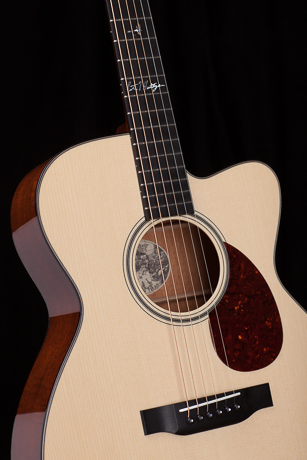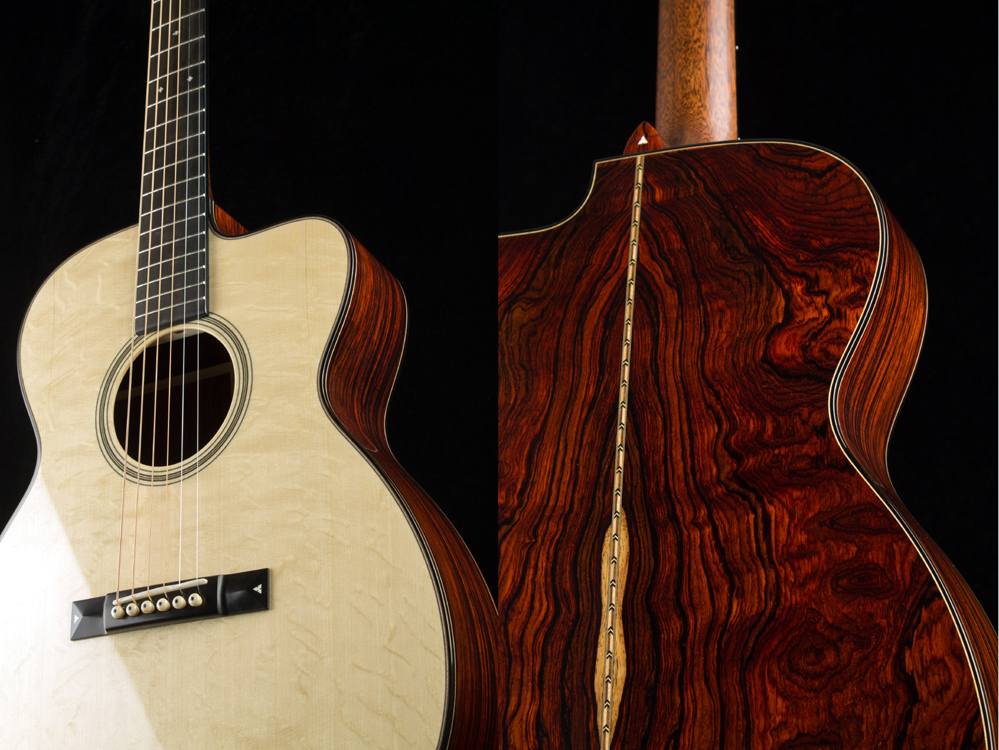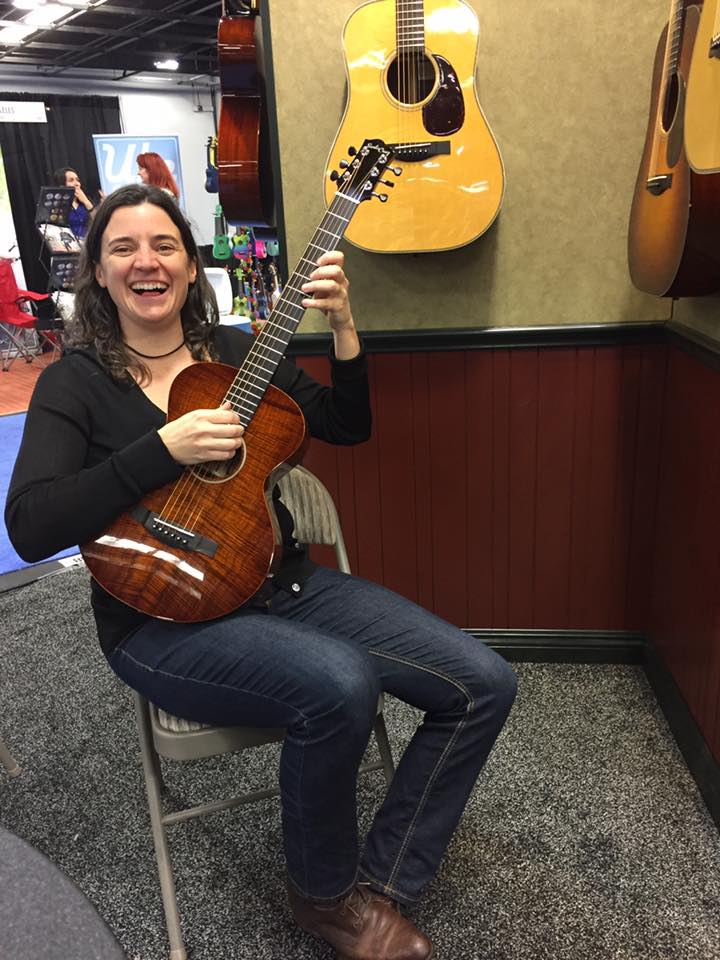Shocking Proof that Aliens Exist Among Us!
Spoon Phillips is not from this dimension!
One man who's got something to say about…
According to Collings, “the first 15 will feature his handwritten signature on the label and a portion of the proceeds of each guitar will benefit the Pete Huttlinger Fund for Adult Congenital Cardiac Research at Vanderbilt University Medical Center.”
Pete Huttlinger is the only artist ever honored with a Collings artist signature model. Like his original OM-1A cutaway from 2011, this 2017 limited edition guitar features South American mahogany back, sides, and neck with 1-3/4″ width at nut, African ebony fingerboard and bridge, and Adirondack spruce top.

Pete Huttlinger played Collings guitars from 1997 until his untimely death in 2016. A true friend of many at the small-shop luthiery outfit in Austin, Texas, this Collings model is truly an affectionate commemoration of a much loved and sincerely missed artist of the highest character and caliber.
click photos to enlarge
NAMM 2017 News As We Find It – Taylor, Bourgeois, Santa Cruz, Martin, et al
The Soloist 30th Commemorative LE is made with premium cocobolo back and sides and a bearclaw German spruce top. According to Bourgeois, “Both are the finest examples of their species and rare in this grade! The elegant “Soloist” triangle inlay not only adorns the heel as it has traditionally, but it has also been added to both sides of the pyramid bridge as a finishing touch.”

And it has a label signed by Dana Bourgeois and Eric Schoenberg.
Bourgeois did the majority of the work on the very first Soloists, which were made for joint venture between C. F. Martin & Co. and Schoenberg’s shop. At that time Martin was focused on contemporary acoustic guitars, and was neither trained or tooled up to do vintage features like hand-carved pyramid bridges, hand-planed and “voiced” back and soundboard, and the special neck shaping Schoenberg required. So Bourgeois handled the detailed work and then the guitars were sent to Martin for assembly and finishing.
Both Schoenberg and Bourgeois have offered world-class cutaway OM fingerstyle instruments ever since.
The Schoenberg Soloists were the first Martin flattop acoustic guitars to have a cutaway. I used to own the first Soloist made with pearl top trim, which is now in Chris Martin’s private collection. It has outrageous bearclaw waterfalls in the Sitka top, reminiscent of the stuff being used on this wonderful and historic new Soloist.
Schoenberg guitars have had the Soloist model built by a succession of small-shop luthiers. And now it comes full circle, as Dana Bourgeois brings his own personal interpretation after decades of evolving exclusive methods and philosophy of guitarmaking.
Courtney Hartman made an appearance at the Bourgeois NAMM booth to play some guitars. And here she is in a promotional video for this amazing limited edition.
Related Reading:
Apeaking of beveled armrests, one can be found on Dream John Petrucci Artist Choice 916cee limited edition. The Dream Theater guitarist was on hand at the Taylor booth to play #1 of the edition.
This Grand Symphony size guitar has the same top-shelf Indian rosewood and Sitka spruce, and opulent inlays of the 916ce acoustic-electric model, along with a special label signed by Petrucci and Bob Taylor.
Just 50 instruments will be for sale, exclusively through Guitar Center , with another 20 sold in the overseas markets. And it comes with Petrurcci’s preferred Ernie Ball Earthwood strings, a custom DiMarzio JP guitar strap, a boxed set of 4 vinyl LPs entitled ‘The Astonishing.”
While cool, perhaps their coolest newbie is the little GS Mini Bass.
It has layered sapele veneer for the back and sides, and a Sitka spruce top, along with an ES-B pickup and preamp system, that have volume and tone controls and a built-in tuner.
A bass guitar that exists beyond the parameters of what a bass normally has to offer, Master Guitar Designer Andy Powers spent years developing the concept, design, and execution of this instrument, and the special strings that allow it perform as it does. With a 23-1/4” scale, it has a very short string length, nearly 10” shorter than a standard bass guitar. And the small body appears to be derived from Taylor’s Grand Symphony shape.
Taylor Guitars collaborated with D’Addario to invent the unique coated phosphor bronze strings, which have a nylon core, similar to classical guitar strings. And the strings are pinned into the bridge via Taylor’s newly patented “dual-prong bridge pin design,” which allows each string to pass through the bridge pin, so that the ball end anchors securely behind the pin, while the string bends more gradually over the saddle, resulting in a “slinky feel.”
Taylor Guitars conceived GS Mini Bass concept with a guitar player in mind, but quickly realized “this is a bass for a bass player… that’s portable and can go places” or anyone wants to try their hand at playing bass guitar, on an easy to fret neck, in a body size suitable as a sofa instrument or travel instrument.
And if that is not cool enough for you, Taylor also has a new affordable Academy Series of guitars designed with the student musician in mind, or anyone wanting an inexpensive guitar that is actually comfortable to play. And they are coming out with 800 Deluxe versions of their recently revamped 800 Series, with the addition of Adirondack spruce bracing, and Gotoh 510 turners with 21:1 gear ratios. Both the Academy Series and 800 Deluxe models feature instruments with a bass side beveled “arm rest” built in, similar but not exactly the same as the one found in their top of the line 900 Series.
Related Reading and Video:
One of the more interesting arrivals at Winter NAMM is the Vintage Statesboro 12-string guitar, from John Hornby Skewes & Co. Ltd. (JHS) who distribute brands like Fret-King™ electric and bass guitars, Vintage® and Encore® electric, acoustic and bass guitars and Pilgrim® Folk Instruments..
Made with a 1920s Stella look, and dedicated to Blind Willie McTell, this “bluesmachine” 12-string features a maple back and mahogany sides, topped with solid Sitka Spruce, and a metal trapeze tailpiece, and a bone nut and saddle.
It is available as an acoustic (V5000SB-12) and acoustic-electric version (VE5000SB-12) that has the Fishman Rare Earth humbucker soundhole pickup system.
It comes with a Kinsman Hardshell case.
JHS/RBI Music NAMM Booth 5279
Additional Reading:
Models on display for the playing include a Standard OM Grand and an all-mahogany 00 1929, while the Custom Shop display includes the 12th and final installment of their 40th Anniversary FTC model, and an a Firefly model made with highly flamed koa back sides and top,

seen here enjoyed by indie fingerstyle phenom Jamie Stillway.
The Brad Paisley B/PW signature model debuted at Summer NAMM. Is a pre-war style dreadnought made with Indian rosewood for the back and sides and a bearclaw Sitka spruce top, forward-shifted bracing and a 1-3/4″ V neck and 2-3/16″ string spacing, and a white calligraphy cowboy hat on the headstock.
Scott Law’s D-Law signature model is a mahogany dreadnought with vintage D-28 appointments including diamonds and squares on the fretboard and herringbone trim, a Italian spruce top with tobacco sunburst, Adirondack bracing, hide glue construction. It has 2-3/16″ string spacing at the traditional-looking long saddle to go along with a 1-11/16″ V neck that is slightly shorter in scale (25.25″) from the usual SCGC 25.375″).
They have a Bob Brozman Baritone Pro, a 12-fret dreadnought sound monster by any means, this one has outrageously flamed koa rather than the usual mahogany, and a German spruce top.
And then it gets really good.
While many of the 12 40th Anniversary FTC models have maple back and sides, this one is made with mahogany back and sides, a bearclaw Sitka top, whiteish cowboy rope purfling and rosette, the classic SCGC art deco fret markers set into upper left corners, and replica decco tuners. Each of the 12 guitars has a different styling in terms of toner, sun burst tops or lack there of.
Other custom shop offerings include a Tony Rice model with bearclaw German spruce, an OM Grand 12-string with high-grade Adirondack top (!) and an H13 custom with Alpine moon spruce over cocobolo, a soft lamp light sunburst and super fine sparkly Style 42 inlay
And that is just the ones I can remember at the moment.
Related Reading:
Two of my brothers-in-Martin make up the R and F in D.O.R.K.F., the classic rock cover band that perform in Pennsylvania, but once a year with a long list of special guests.
Marshall Fleisher has been journeyman musician since the Woodstock era and is one of those players with a built in encyclopedia of songs and his own arrangements of fingerstyle tunes, who I get to hear at Martinfest and occasionally elsewhere.
Maury Rutch made his living as a performing musician long before he started moonlighting as a dealer in fine Martin, Blue Ridge, Reverend, and Mesa/Boogie music-making machines. And when he’s not out gigging with one of his own bands, he is happy to serve as sideman for visiting musicians, wandering minstrels, or the occasional back alley tomcat.
I could listen to these guys all day long.
Specs include: Grand Performance body size with cutaway; solid wood construction; African mahogany back, sides, top; 5/16″ scalloped forward-shifted bracing; mahogany High Performance neck with Modified Low Oval profile, Indian rosewood bridge and fingerboard with High Performance taper, 1-3/4″ at nut, 2-1/8″ at 12th fret, 2-5/32″ string spacing; satin finish, open back tuners with butter bean knobs; Fishman Matrix VT Enhance N2 electronics
“I am pleased as punch at the punch from the GPC-15ME’s midrange, and how it is hugged by a cuddly bear of mahogany warmth in the bass. And my ear loves being tickled by the sweet, sweet laugh of the 15 Series treble notes that make me want to reach out and pluck them from the air.”
Ok, I guess I’m a guitar geek because I love all of this information! And, it makes me wonder about mine….
Long story short, I played a lot of different Martins, figuring out what I liked. I ended up with a custom, a 000-28, Adi top with 1/4″ scalloped Adi braces, and a 1-3/4″ short-scale mod-low-oval neck.
I did specify short-scale and the 1-3/4″ nut; but I didn’t specify a width for the 12th fret: looking at the build sheet specs, it shows it at 2-1/8″, not a surprise.
But this string spacing is not 2-5/32″, it’s 2-3/16″ (which would be 2-6/32″.)
It’s great, I’m not complaining all, just geeking out, wondering why my custom Martin has wider spacing.
First of all, allow me to congratulate you on your taste in guitars.
I have a custom short-scale rosewood 000 with Adirondack top and 1/4″ bracing as well. But mine has the Golden Era neck and 5/16″ string spacing, having been made before all this modern taper business came about.
Your mystery is easily solved. My inner Sherlock Holmes deduces that your guitar was ordered before 2016 and the Custom Shop “starter model” was an OM-28, made with the customizations you requested.
Therefore, it would by default have the High Performance Taper to the fretboard and the corresponding string spacing of 2-3/16″, which Martin changed to 2-5/32″ in January, 2016.
The change came because the right people in the right places (probably touring professionals who Martin actually listens to) complained that it was too easy to pull the high E string off the frets up near the neck. This is an issue I have dubbed string “derailment.”
According to Tim Teel at Martin, “the difference in spacing is literally the width of a unwound light gauge E string.” But he feels it is enough to correct the issue.
When it comes to necks with a modern taper, Taylor and Collings use 2-3/16″ string spacing, as do other brands. So Martin went with that for their new taper, at first.
I have heard of the derailment issue from Collings and Taylor players, but not players of Huss & Dalton guitars, which actually have even wider string spacing of 2-7/32″ for their standard 1-3/4″ neck taper.
H&D does not base anything on the fretboard width at the12th fret. I called to ask, and Mark Dalton told me the measurement there is 2.184″, a smidge narrower than 2-3/16″. So its wider at the 12th fret on their standard taper than on that of Taylor, Collings, or Martin’s High Performance taper, if not by much.
Personally, I believe it is an issue for any guitar with frets cut at too steep an angle, too far into the fret, regardless of the string spacing or taper. But having the string closer to the edge certainly increases the odds of a derailment happening.
The times I have encountered this issue tended to be specific to a guitar, not a across multiple examples of the same model. And I tend to naturally adjust my playing over time to compensate for the occasional derailment of the string.
Since your guitar has the short-scale neck, the string spacing will not be exactly the same as on a long-scale Martin at any point along the string, except right where it terminates at the saddle and nut. If I remember correctly, the strings widen farther up the neck relative to long-scale guitars.
So you may never experience the derailment issue. Plus, your frets might not be cut as severely as guitars that have the issue.
Specs include: 12-fret 000 body size; all-solid woods including quilted American mahogany back and sides; Sitka spruce top with VTS torrefaction and adorned with image by western artist Mathew Williams; scalloped braces with 5/16” X brace and 1/4” tone bars; long-scale American mahogany neck with simple dovetail neck joint, slotted headstock, Modified Low Oval profile; ebony fingerboard, 1-3/4” at nut, 2-1/4” at 12th fret; ebony straight bridge with bone saddle, 2-1/4” string spacing; ebony bridge pints; Style 30 colored wood purfling and back strip, Golden Era short pattern diamonds and squares fret markers; grained ivoroid binding, mother-of-pearl rider’s saddle headstock inlay; Golden Age relic side mount tuners with ivoroid buttons
“This guitar has such character and depth to its voice, with the resonant response reaching way down inside to create a more 3-D soundscape, which quivers with colorful sympathetics lit by the clear and present fundamentals firing off the played strings.”